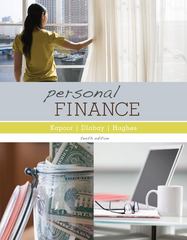Question
Elliot Karlin is a 35-year-old bank executive who has just inherited a large sum of money. Having spent several years in the bank's investments department,
Elliot Karlin is a 35-year-old bank executive who has just inherited a large sum of money. Having spent several years in the bank's investments department, he's well aware of the concept of duration and decides to apply it to his bond portfolio. In particular, Elliot intends to use $1 million of his inheritance to purchase 4 U.S. Treasury bonds:
1. An 8.52% , 13-year bond that is priced at $1088.13 to yield 7.45%.
2. A 70.777% , 15-year bond that's priced at $1019.27 to yield 7.56%.
3. A 20-year stripped Treasury (zero coupon) that's priced at $198.90 to yield 8.24%.
4. A 24-year, 7.41% bond that's priced at $950.72 to yield 7.87%.
Note that these bonds are semiannual compounding bonds.
a. Find the duration and the modified duration of each bond.
b. Find the duration of the whole bond portfolio if Elliot puts $250,000 into each of the 4 U.S. Treasury bonds.
c. Find the duration of the portfolio if Elliot puts $310,000 each into bonds 1 and 3 and $190,000 each into bonds 2 and 4.
d. Which portfolio---b or c---should Elliot select if he thinks rates are about to head up and he wants to avoid as much price volatility as possible? Explain. From which portfolio does he stand to make more in annual interest income? Which portfolio would you recommend, and why?
a. The duration and modified duration can be calculated using a spreadsheet, such as Excel. It gives the precise duration measure because it avoids the rounding-off errors, which are inevitable with manual calculations.
Bond 1: 13 years, 8.52%, priced to yield 7.45%
The duration of this bond is . years. (Round to two decimal places.)
The modified duration of this bond is years. (Round to two decimal places.)
Bond 2: 15 years, 7.777% priced to yield 7.56%.
The duration of this bond is ... years. (Round to two decimal places.)
The modified duration of this bond is years. (Round to two decimal places.)
Bond 3: 20 years, zero coupon, priced to yield 8.24%.
The duration of this bond is. years. (Round to two decimal places.)
The modified duration of this bond is. years. (Round to two decimal places.)
Bond 4: 24 years, ,7.41% priced to yield 7.87%.
The duration of this bond is years. (Round to two decimal places.)
The modified duration of this bond is . years. (Round to two decimal places.)
b. Find the duration of the whole bond portfolio if Elliot puts $250,000 into each of the 4 U.S. Treasury bonds.
The duration of this portfolio is .. years. (Round to two decimal places.)
c. Find the duration of the portfolio if Elliot puts $310,000 each into bonds 1 and 3 and $190,000 each into bonds 2 and 4.
The duration of this portfolio is years. (Round to two decimal places.)
d. Which portfolio---the portfolio in part b or the portfolio in part c should Elliot select if he thinks rates are about to head up and he wants to avoid as much price volatility as possible?(Choose the best answer below.)
A. He should invest in the portfolio in part C. The portfolio in part B has a higher duration than the portfolio in part C. If rates are about to rise, then it is safer to invest in the portfolio in part C , because it would be less price volatile than the other portfolio.
B. He should invest in the portfolio in part C. The portfolio in part C has a higher duration than the portfolio in part B. If rates are about to rise, then it is riskier to invest in the portfolio in part B , because it would be more price volatile than the other portfolio.
C. He should invest in the portfolio in part B. The portfolio in part C has a higher duration than the portfolio in part B. If rates are about to rise, then it is safer to invest in the portfolio in part B, because it would be less price volatile than the other portfolio.
D. He should invest in either portfolio. The portfolio in part C has a higher duration than the portfolio part B . If rates are about to rise, then it is equally safe to invest in either portfolio, because both portfolios would be equally price volatile.
Step by Step Solution
There are 3 Steps involved in it
Step: 1

Get Instant Access to Expert-Tailored Solutions
See step-by-step solutions with expert insights and AI powered tools for academic success
Step: 2

Step: 3

Ace Your Homework with AI
Get the answers you need in no time with our AI-driven, step-by-step assistance
Get Started


